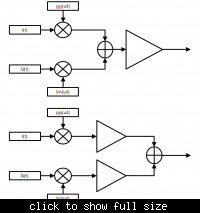mtwieg
Advanced Member level 6
Recently I had the idea of implementing a quadrature modulated PA by using two separate amplifiers, one for Q and one for I, and combining the outputs. This is opposed to normal quadrature modulation where the combination if I and Q is done before the amplifier(s), and the amplifier amplifies the both at the same time. I was thinking that for high power, doing the combination after the amps would involve less combiners and splitters overall.
Anyways, my question is whether there is a method of combining quadrature signals in a way that preserves the quadrature output (meaning it's not a standard quadrature coupler, which shifts the IQ signals to be coherent as they're combined. I'm not talking about balanced amplifiers here.), while not having 3dB of loss that seems to normally result from out of phase signals. I'm wondering if it's even theoretically possible for such a combination to occur, at least without having terrible isolation that is. Same thing for signals of different magnitude as well.
Any thoughts?
Anyways, my question is whether there is a method of combining quadrature signals in a way that preserves the quadrature output (meaning it's not a standard quadrature coupler, which shifts the IQ signals to be coherent as they're combined. I'm not talking about balanced amplifiers here.), while not having 3dB of loss that seems to normally result from out of phase signals. I'm wondering if it's even theoretically possible for such a combination to occur, at least without having terrible isolation that is. Same thing for signals of different magnitude as well.
Any thoughts?
